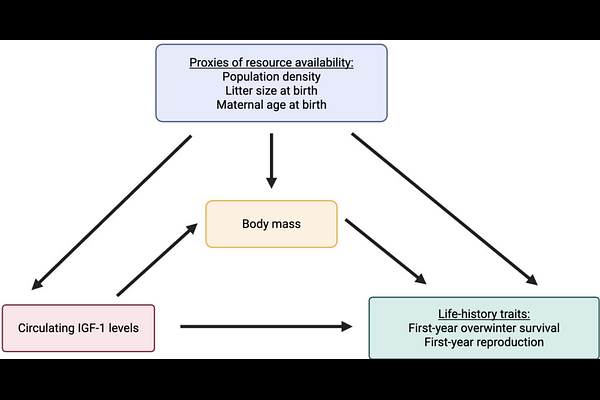Plasma insulin-like growth-factor 1 (IGF-1) concentrations predict early life-history traits in a wild mammal

Plasma insulin-like growth-factor 1 (IGF-1) concentrations predict early life-history traits in a wild mammal
Ravindran, S.; Corripio-Miyar, Y.; Pick, J. L.; Bal, X.; Pilkington, J. G.; Pemberton, J. M.; Nussey, D. H.; Froy, H.
Abstract1. Understanding the physiological mechanisms underpinning plasticity in life-history traits can help us predict individual responses to environmental variability and understand how diverse life-history strategies evolve to be shaped by ecological processes. 2. The hormone insulin-like growth factor 1 (IGF-1) is a key player in the insulin/IGF-1 signaling (IIS) pathway. This nutrient-sensing pathway responds to diverse environmental cues including food availability and has been shown to modulate the association between resource acquisition and allocation of resources to life-history traits like growth, reproduction and survival in the laboratory. 3. We measured IGF-1 concentrations in blood samples from approximately four-month-old wild Soay sheep lambs (n=669), collected over nine summers. We tested whether IGF-1 was positively correlated with proxies of resource availability, and whether IGF-1 was associated with morphological traits measured concurrently and predicted subsequent fitness-related traits. 4. Plasma IGF-1 concentrations were higher in males compared to females, and positively correlated with measures of resource availability in both sexes. IGF-1 was lower in years of high population density when per capita food availability was reduced; in twin lambs who have fewer available resources compared to singletons; and in lambs born to young and old mothers, who have poor maternal provisioning compared to mothers of intermediate age. 5. Higher IGF-1 levels in summer were predictive of higher body mass, faster post-natal somatic growth and increased skeletal size, measured at the same time. These associations were independent of our proxies of resource availability. 6. Lambs with higher summer IGF-1 were more likely to survive their first winter and reproduce the following spring. The association between IGF-1 and reproduction was independent of our resource availability proxies, whereas the association with first-winter survival was not. The association between summer IGF-1 and reproduction was mediated by positive associations with summer body mass. 7. Our study reveals population-level phenotypic plasticity in circulating IGF-1, also finding IGF-1 to predict early life-history traits in a wild mammal population.